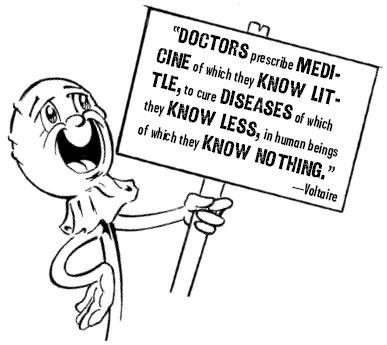When All Hell Breaks Loose (83 page)
Read When All Hell Breaks Loose Online
Authors: Cody Lundin
Dealing with a Wound Infection

1
Wash hands with soap and water and clean the surrounding skin area with a topical disinfectant.2
If not already opened, open the wound gently using a sterile object to allow the buildup of pus to drain. Soaking the wound in warm water beforehand will help the wound drain more easily by dissolving the crusty serum and pus that sometimes keeps a wound closed. Pus can form in multiple pockets deep within a wound so inspect it to see if there are others that need to be drained other than the obvious. It's very important that infected wounds be allowed to properly drain. As long as an infection is present, don't allow the wound to close on its own. This can be accomplished by inserting a piece of dry, sterile gauze into the wound, which should be changed whenever the dressing is changed.3
Soak the wound in warm, disinfected water four times per day for twenty to thirty minutes, with or without a small amount of added povidone-iodine. The warm water also helps in the healing process as the heat dilates the blood vessels, bringing more blood to the infected area.4
After soaking, carefully dry the affected area and change the dressings as often as required to keep them clean and dry.5
Give over-the-counter pain medications if needed such as ibuprofen, aspirin, or acetaminophen. Aspirin is a blood thinner so use with caution.6
For advanced infections, the use of antibiotics will most likely be required. Important Note: Most antibiotics are available by prescription only and, like any other drug, have a shelf life. Consult with your family physician about having a ready supply of topical antibiotics for a disaster scenario in which medical response may be severely limited or delayed. People traveling to remote countries often take with them a doctor-prescribed supply of oral antibiotics due to meager resources or to deal with just-in-case scenarios.
Burns
Burns will also be a very common injury due to the flourishing use of alternative lighting devices and the general population's renewed reliance on fire for heating and cooking. Thanks to gestapo-like federal forest regulations regarding fire use and the neutered, unrealistic views of banning campfires in the back country by gear-addicted, politically correct outdoor companies, even well-seasoned outdoors-men and women are hopelessly clueless about the creation, use, and extinguishing of fire. Can you imagine the burn injury rate if every household needed to use fire to get their needs met as was done for thousands of years?
Burn Classifications
There are three types or classifications of burns,
first degree, second degree
, and
third degree
. In a first-degree burn, the outer layer or epidermis is affected and the skin appears mildly red, swollen, and painful, but no blisters are formed. Almost everyone has experienced this in the form of a common sunburn. Second-degree burns pass through the epidermis and extend into the dermis or secondary layer of skin. The pain and swelling is moderate and blisters are present. Both of these burns are classified as partial-thickness burns. Third-degree burns reach into the underlying fat and muscle tissue of the body and are termed full-thickness burns. The skin appears charred and leathery, is numb to the touch from the burn victim's standpoint, and for all intents and purposes is "dead." Much like a piece of wood in a fire, a single burn upon the body can exhibit characteristics of all three burn classifications.
How much of the body was burned, where the burn(s) occurred, and whether the burns are partial or full thickness will determine how the patient is treated and what their odds for survival are. Burns to the face, neck, hands, feet, genitalia, and buttocks are serious. Facial burns can cause serious damage to the respiratory tract and compromise breathing. Burns completely encircling the body (circumferential burn) can have a tourniquet effect on the body. I won't go into the details for major burns or burns that involve much of the body, as people with these burns will need hospitalization if they are to survive. With no hospitalization they will most likely die from "burn shock" caused by damaged capillaries allowing blood serum to leak into the burned tissue. This fluid loss reduces the blood volume of the body and rapidly causes shock just like a major bleeding incident. People with severe burns require massive amounts of fluids to survive, which must usually be given intravenously.
Important!
All serious burns will need advanced medical care as soon as possible!
Dealing with a Burn
Immediately STOP the burning!
Pour cold water over the burned area as quickly as possible and remove burned clothing. Clothing and jewelry around the burn should be removed before swelling takes place. To lesson the pain, smaller, partial-thickness burns will benefit from "cold" such as a towel soaked in ice water or the immersion of the burn into clean, cold water. Like any other open wound, clean the burn of all debris, keep it clean, and prevent blisters from rupturing.
After cleaning and drying the burn, most medical manuals recommend covering all second-degree burns and some third-degree burns with a thin layer of antibiotic ointment. Cover the wound with a clean or sterile nonstick dressing and bandage. If the burn is wet or oozes, wash the area daily with clean warm water, dry, and reapply a new dressing and bandage. For most third-degree burns, it's recommend that you cover the area with a dry, sterile, or at least clean, dressing. Ibuprofen is probably the best over-the-counter remedy for the pain associated with the burn. Burn victims will be dehydrated and should be encouraged to drink extra water although, as indicated above, advanced injuries will require intravenous fluids. Serious burn victims should be transported to the nearest medical facility for advanced care.
Although rarely mentioned in medical manuals, pure honey is amazing when applied topically to burns. Use only quality honey, not the cheap stuff cut with corn syrup. In this case the honey is used similar to the antibiotic ointment mentioned above. After cleaning the burn, apply honey and then a clean dressing, bandaged in place.
Dreadful Diarrhea
Diarrhea is caused by a number of variables that will be all too common in survival land. Intestinal infections from poorly disinfected water, food poisoning from eating spoiled stored food or from sampling weird food options, food sensitivities and allergies of family members that you never knew had an allergy to powdered milk, and plain old stress can all cause the screaming turkey trots.
There are two main types of diarrhea. One is the less serious and more common "
traveler's diarrhea
." The other is the more invasive
bacterial diarrhea
. The difference in their effects is that bacterial diarrhea will have the added gifts of chills and fever, along with blood, obvious pus, or mucous in the stool. This type of diarrhea is very serious and will need to be treated with antimicrobial medication. Antidiarrheal medications such as Pepto-Bismol or Imodium AD should NOT be used with bacterial diarrhea as they could prolong the illness. Affected people under three years old, over sixty-five, who are pregnant, or who have had severe diarrhea for more than forty-eight to seventy-two hours with abdominal tenderness along with the above added symptoms should seek medical care as soon as possible.
Traveler's diarrhea caused by critters, usually
E.coli
bacteria, has an incubation period of twelve to forty eight hours and lasts from two to five days. Besides copious, horrid-smelling watery squirts, the symptoms of abdominal stress, obnoxious bowel sounds, and cramps are unmistakable to most everyone. Besides being a major bummer, severe diarrhea (categorized as ten bowel movements per day or more) and the severe dehydration it causes can kill very young, very old, or weaker family members, especially when visiting the hospital might be dubious at best after a calamity.

Treatment for Traveler's Diarrhea
The replacement of fluids and electrolytes (sodium and potassium) is of prime importance to all victims of diarrhea
. Remember to check your pee for adequate hydration levels (urine should be clear, frequent, and copious) and use the homemade electrolyte replacement solution as needed as mentioned on Chapter 13. Broths, soups, and fruit juices can also be consumed. To keep up with the dehydrating effects of diarrhea, you may need to drink several quarts of fluid each day. It may also help to avoid milk products and meats for forty-eight hours afterward as well as diuretics such as coffee.
Antidiarrheal medications (Pepto-Bismol, Imodium AD, or Lomotil) vary in their potency and effectiveness person by person. Some medical professionals feel that their use prolongs diarrhea, even traveler's diarrhea. They should be used at your discretion for controlling painful cramps or during circumstances that are far more dangerous or uncomfortable than diarrhea itself, such as needing to stay in a bathroomless basement during a tornado or having to pile into an evacuation bus with dozens of other victims. Prolonged, moderate diarrhea caused by stress and fear (irritable colon syndrome) is best treated by hydration and electrolyte replacement, reassuring and comforting the person, and, of course, dealing with and eliminating the cause of the stress if possible.
Constipation
On the other end of the spectrum, survival stresses such as the consumption of monotonous, "different," stored survival foods, dehydration, erratic schedules, and stress in general can cause constipation, which is more the passing of hard, dry stools rather than the frequency of a person's bowel movement. Different people have different bowel movement schedules. Some people poop three times a day and others poop once every three days. Only you know when your schedule is off.
STAPHYLOCOCCAL ENTERITIS:
IT'S WHAT'S (WAS) FOR DINNERStaphylococcal Enteritis
bacteria are present on nearly half of the population's hands on a good day, let alone during a survival situation, thus the bacteria commonly contaminate foods during hands-on preparation. Any food can become contaminated with the bacteria but they are more commonly a problem in milk products and other food such as mayonnaise and meats. Staphylococcal toxin is produced when contaminated food goes without refrigeration for several hours (such as during a power outage), causing the toxin to multiply. Once it's present, even boiling the food doesn't kill the toxin. Only refrigeration or consumption of food immediately after it's prepared can prevent this bug and others like it from doing their thing. Cramps, diarrhea, and sometimes vomiting begin within one to six hours after eating the suspect food and last until the food is emptied from the body, usually six hours. I mention it here, as it could be a common dinner guest at the onset of any power-failure-related emergency.
I have had more than one student become constipated on a stressful field course and not have a bowel movement for three days or more. A change in diet, dehydration, and the low-level stress of being at the mercy of a freaky guy in the woods takes its toll on their colon and they "lock up," so to speak. If the problem doesn't take care of itself in the field when they eventually get used to the routine and settle down, once back in the comfort of their own homes, they gleefully give birth to the mother lode.